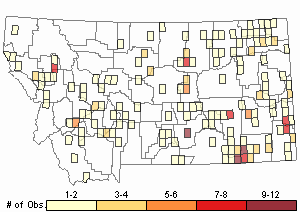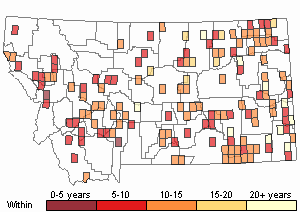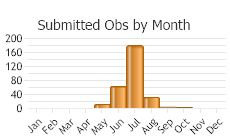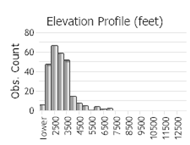View in other NatureServe Network Field Guides
NatureServe
Montana
Utah
Wyoming
Idaho
Wisconsin
British Columbia
South Carolina
Yukon
California
New York
Twelve-spotted Skimmer - Libellula pulchella
Native Species
Global Rank:
G5
State Rank:
S5
(see State Rank Reason below)
Agency Status
USFWS:
USFS:
BLM:
External Links
State Rank Reason (see State Rank above)
This species is widespread and abundant throughout the state.
- Details on Status Ranking and Review
Twelve-spotted Skimmer (Libellula pulchella) Conservation Status Review
Review Date = 09/18/2008
Population Size
ScoreU - Unknown
CommentUnknown.
Range Extent
ScoreF - 20,000-200,000 km squared (about 8,000-80,000 square miles)
Comment20,000-200,000 km2 (125,000-500,000 acres)
Area of Occupancy
ScoreF - 500-2,000 km squared (about 125,000-500,000 acres)
Comment500-2000 km2 (125,000-500,000 acres)
Long-term Trend
ScoreF - Increase (increase of >25%)
CommentStock Pond creation in the prairies has increased the habitat for this species
Short-term Trend
ScoreE - Stable. Population, range, area occupied, and/or number or condition of occurrences unchanged or remaining within ±10% fluctuation
CommentDocumenting many additional populations since 2006
Threats
ScoreG - Slightly threatened. Threats, while recognizable, are of low severity, or affecting only a small portion of the population or area.
CommentWetland loss, Climate Change, Drought
SeverityLow - Low but nontrivial reduction of species population or reversible degradation or reduction of habitat in area affected, with recovery expected in 10-50 years.
ScopeLow - 5-20% of total population or area affected
CommentNo threats identified
ImmediacyLow - Threat is likely to be operational within 5-20 years.
CommentNo threats identified
Intrinsic Vulnerability
ScoreC - Not Intrinsically Vulnerable. Species matures quickly, reproduces frequently, and/or has high fecundity such that populations recover quickly (< 5 years or 2 generations) from decreases in abundance; or species has high dispersal capability such that extirpated populations soon become reestablished through natural recolonization (unaided by humans).
Environmental Specificity
ScoreD - Broad. Generalist. Broad-scale or diverse (general) habitat(s) or abiotic and/or biotic factors are used or required by the species, with all key requirements common in the generalized range of the species in the area of interest. If the preferred food(s) or breeding/nonbreeding microhabitat(s) become unavailable, the species switches to an alternative with no resulting decline in numbers of individuals or number of breeding attempts.
General Description
The 12 spotted skimmer is a large showy dragonfly in the skimmer family; it looks even larger when flittering around the wetland because of the numerous spots placed along the length of the wing (6 spots on each side with black at the tip, a white spot nearest the tip is the Eight-spotted Skimmer). In mid-summer (July & August), they are very active and territorial often covering the whole wetland or lake shore on patrol and then returning back to the same area. This species is found statewide in ponds, lakes and wetlands with abundant emergent vegetation and oftentimes some open water. Like all adult dragonflies they eat smaller flying insects such as mosquitoes and flies, but will also take down damselflies and moths.
Phenology
Adults are most active in mid-summer, July & August, but can persist into September.
Diagnostic Characteristics
The 12 spotted skimmer has numerous spots alternating white and black along the length of the wing (6 spots on each side with black at the tip, 4 spots per wing and a white spot nearest the tip is the Eight-spotted Skimmer).
Species Range
Montana Range
Range Descriptions

 Native
Native
Observations in Montana Natural Heritage Program Database
Number of Observations: 329
(Click on the following maps and charts to see full sized version)
Map Help and Descriptions
Relative Density

Recency



 (Observations spanning multiple months or years are excluded from time charts)
(Observations spanning multiple months or years are excluded from time charts)
Migration
Although there is no evidence of Twelve-spotted Skimmers migrating to or from Montana, some individuals do indeed migrate along the Atlantic coast (Dunkle 2000, Nikula et al. 2002).
Habitat
Twelve-spotted Skimmers prefer habitats of lakes and ponds, often shallow or semipermanent, as well as slow streams, marshes, and bogs. They are also commonly encountered in open fields where they forage (Dunkle 2000, Nikula et al. 2002, Paulson 2009).
National Vegetation Classification System Groups Associated with this Species
Sparse and Barren
Sparse and Barren
Wetland and Riparian
Alkaline - Saline Wetlands
Alpine Riparian and Wetland
Peatland
Riparian and Wetland Forest
Riparian Shrubland
Wet Meadow and Marsh
Food Habits
Larvae feed on a wide variety of aquatic insects, such as mosquito larvae, other aquatic fly larvae, mayfly larvae, and freshwater shrimp. They will also eat very small fish and tadpoles.
Adult- The dragonfly will eat almost any soft-bodied flying insect including mosquitoes, flies, small moths, mayflies, and flying ants or termites.
Reproductive Characteristics
Male Twelve-spotted Skimmers are more territorial than Eight-spotted Skimmers with lengthy flights back and forth along shoreline and open water areas, but these territories change daily. Males are very aggressive towards other males and territorial disputes are common, involving repeated vertical loops and the male who succeeds in circling his competition is considered the winner. Copulation is quick and completed in flight. Females oviposit by splashing eggs into dense emergent vegetation or floating logs with male guarding nearby, although this guarding is only effective at low population densities (Nikula et al. 2002, Paulson 2009).
Stewardship Responsibility
References
- Literature Cited AboveLegend:
 View Online Publication
View Online Publication Dunkle, S.W. 2000. Dragonflies through binoculars: A field guide to dragonflies of North America. New York, NY. Oxford University Press. 266 pp.
Dunkle, S.W. 2000. Dragonflies through binoculars: A field guide to dragonflies of North America. New York, NY. Oxford University Press. 266 pp. Nikula, B., J. Sones, D.W. Stokes, and L.Q. Stokes. 2002. Stokes beginner's guide to dragonflies and damselflies. Boston: Little, Brown. 159 pp.
Nikula, B., J. Sones, D.W. Stokes, and L.Q. Stokes. 2002. Stokes beginner's guide to dragonflies and damselflies. Boston: Little, Brown. 159 pp. Paulson, D.R. 2009. Dragonflies and Damselflies of the West. Princeton University Press, Princeton. 535 pp.
Paulson, D.R. 2009. Dragonflies and Damselflies of the West. Princeton University Press, Princeton. 535 pp.
- Additional ReferencesLegend:
 View Online Publication
View Online Publication
Do you know of a citation we're missing? Hendricks, P., S. Lenard, D.M. Stagliano, and B.A. Maxell. 2013. Baseline nongame wildlife surveys on the Fort Peck Indian Reservation. Report to the Assiniboine and Sioux Tribes of the Fort Peck Indian Reservation. Montana Natural Heritage Program, Helena, MT. 83 p.
Hendricks, P., S. Lenard, D.M. Stagliano, and B.A. Maxell. 2013. Baseline nongame wildlife surveys on the Fort Peck Indian Reservation. Report to the Assiniboine and Sioux Tribes of the Fort Peck Indian Reservation. Montana Natural Heritage Program, Helena, MT. 83 p. Maxell, B.A. 2016. Northern Goshawk surveys on the Beartooth, Ashland, and Sioux Districts of the Custer-Gallatin National Forest: 2012-2014. Montana Natural Heritage Program. Helena, MT. 114pp.
Maxell, B.A. 2016. Northern Goshawk surveys on the Beartooth, Ashland, and Sioux Districts of the Custer-Gallatin National Forest: 2012-2014. Montana Natural Heritage Program. Helena, MT. 114pp. Nelson, Howard E. 1953. The summer dragonflies of Flathead Valley, Montana. M.A. Thesis. University of Montana. Missoula, MT.
Nelson, Howard E. 1953. The summer dragonflies of Flathead Valley, Montana. M.A. Thesis. University of Montana. Missoula, MT. Sater, S. 2022. The insects of Sevenmile Creek, a pictorial guide to their diversity and ecology. Undergraduate Thesis. Helena, MT: Carroll College. 242 p.
Sater, S. 2022. The insects of Sevenmile Creek, a pictorial guide to their diversity and ecology. Undergraduate Thesis. Helena, MT: Carroll College. 242 p.
- Web Search Engines for Articles on "Twelve-spotted Skimmer"
- Additional Sources of Information Related to "Insects"





